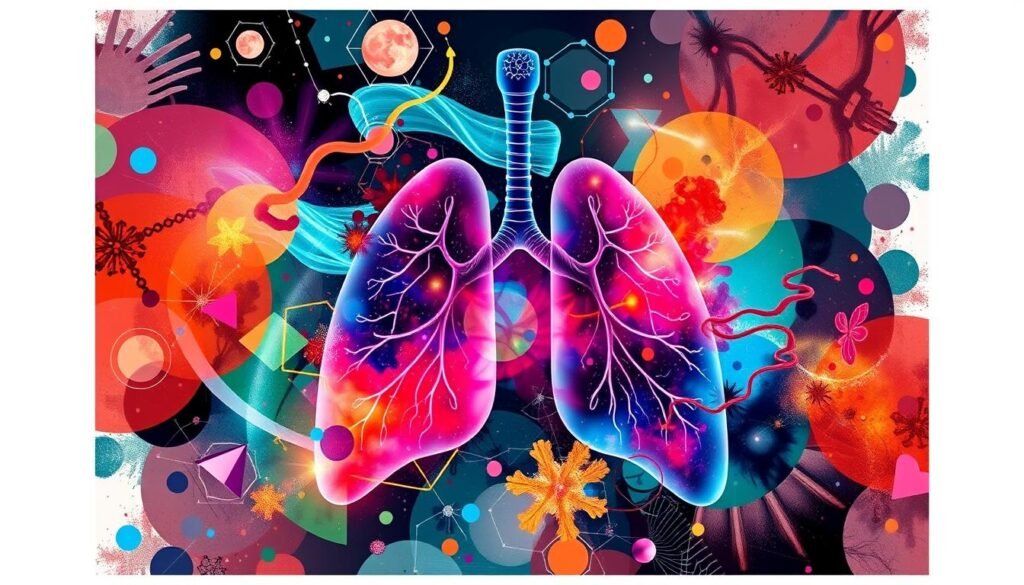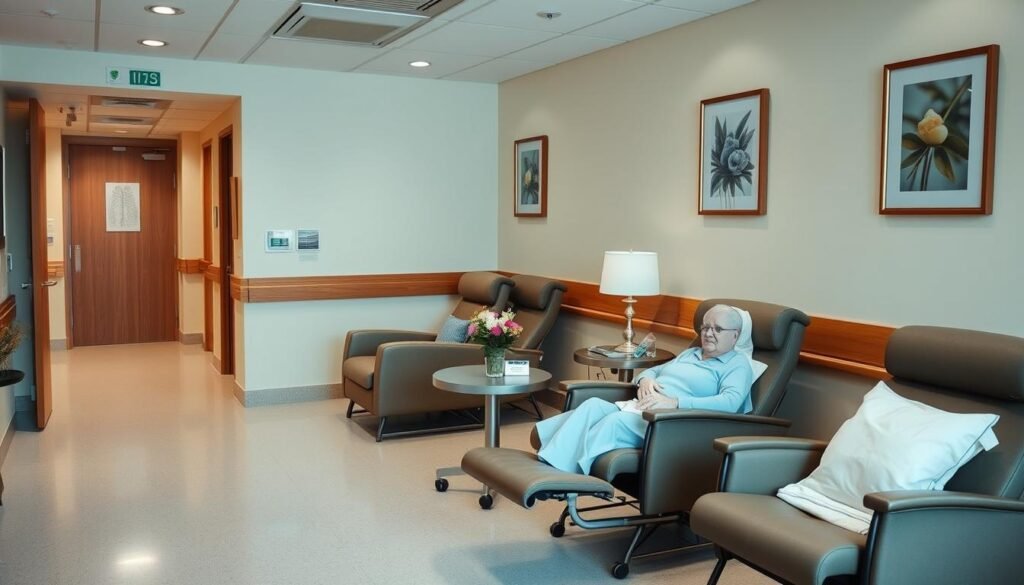Did you know quitting smoking after being diagnosed with lung cancer leads to better health outcomes? This fact highlights the value of understanding lung cancer treatments. It shows how they affect patient recovery. The field of lung cancer is changing fast. This makes it vital to look into the best treatment options to offer personalized care.
There are many advanced lung cancer treatments available today. These include surgery, chemotherapy, and radiation, as well as newer methods like targeted therapies and immunotherapy. Each method has its own benefits. Knowing these options helps patients and their families navigate the path to recovery. For more details on how Ommaya reservoirs are used in treatment, visit advanced options in lung cancer therapy.
Understanding the details of treatment options is critical. It’s important to consider the stage of the cancer, the patient’s general health, and new treatment innovations. These factors all play a crucial role in creating effective treatment plans.
Key Takeaways
- Quitting smoking post-diagnosis can lead to better outcomes for lung cancer patients.
- Stage 0 NSCLC is often curable with surgery alone.
- Neoadjuvant chemotherapy is common for stage II NSCLC before surgical intervention.
- Advanced lung cancer treatments may include a combination of therapies based on the cancer stage.
- Lung cancer screening is advised for those 50 and older with a significant smoking history.
- Palliative care complements traditional treatments to improve quality of life.
Understanding Lung Cancer
Lung cancer affects millions worldwide every year. It’s important to learn about it to improve detection and treatment. Knowing the different types can help in finding the right treatment.
Definition and Types of Lung Cancer
There are two main kinds of lung cancer: non-small cell lung cancer (NSCLC) and small cell lung cancer (SCLC). About 85% of cases are NSCLC. This group includes adenocarcinoma, squamous cell carcinoma, and large cell carcinoma. SCLC is more aggressive and spreads quickly.
Understanding the cancer type is crucial for choosing treatments. Some may need surgery, especially if the cancer hasn’t spread far. Treatments must be tailored to each person’s specific type of cancer.
Importance of Early Detection
Finding lung cancer early can save lives. Screenings, like low-dose CT scans, are good for those 50-80 with a history of smoking. Being diagnosed early means more treatment options and a better chance of survival.
Early detection allows for aggressive treatment. This can lead to better outcomes for patients. It’s vital to raise awareness about regular screenings. They help find cancer early when it’s easier to manage.
Available Treatment Options for Lung Cancer
People with lung cancer have several treatment choices. It’s important to know about these options to manage the disease well. The main methods include surgery, radiation therapy, and chemotherapy. Each plays a key role based on the cancer’s type, its stage, and the patient’s health.
Surgery as a First-Line Treatment
Surgery is often the first choice for treating localized tumors. It may involve different techniques like lobectomy, segmentectomy, and pneumonectomy. Recovery from open surgery usually takes 6 to 8 weeks. But, minimally invasive methods can shorten this period. Checking nearby lymph nodes during surgery helps doctors see if the cancer has spread. This is vital for planning further treatment.
Radiation Therapy for Lung Cancer
Radiation therapy targets cancer cells with high-energy beams, such as x-rays. It can be used alone or with surgery and chemotherapy. This is often the case for advanced lung cancer. SBRT focuses on small tumors. Whereas traditional therapy might need 20 to 32 sessions. Patients should talk to their doctors about side effects like fatigue and skin irritation.
Chemotherapy for Lung Cancer
Chemotherapy is a systemic treatment. It uses medication to destroy cancer cells. Treatments are given in cycles, with breaks in between. Chemotherapy might be suggested after surgery for early-stage non-small cell lung cancer. If surgery isn’t an option, it can be the main treatment, sometimes used with radiation therapy.
For detailed information on the best lung cancer treatments, including new therapies, talk to a healthcare professional. They can provide a treatment plan that’s right for you.
| Treatment Method | Purpose | Typical Duration | Side Effects |
|---|---|---|---|
| Lung Cancer Surgery | Remove tumor and surrounding lymph nodes | 6-8 weeks recovery | Pain, infection risk, breathlessness |
| Radiation Therapy | Target cancer cells with high-energy beams | 20-32 sessions (4-7 weeks) | Fatigue, skin irritation, swallowing difficulties |
| Chemotherapy | Kill cancer cells via bloodstream | Cycled treatment (varies per regimen) | Nausea, hair loss, fatigue |
Advanced Treatment Modalities
Lung cancer treatment has made a big leap forward with new methods. These methods cater to each person’s unique genetic makeup and tumor traits. Targeted therapy and immunotherapy are leading the way, showing better results for patients.
Targeted Therapy for Lung Cancer
Targeted therapies zero in on certain genes that make cancer grow. Drugs like osimertinib and alectinib target specific mutations, such as EGFR and ALK. This approach offers a more customized way to tackle lung cancer. It often leads to fewer side effects and better outcomes.
Thanks to ongoing innovation, there are more and more options for patients with different genetic markers.
Immunotherapy for Lung Cancer
Immunotherapy is a new weapon against lung cancer. Drugs like pembrolizumab and nivolumab boost the body’s immune system to attack cancer cells. They are used in various stages of lung cancer and have helped improve survival rates.
With support from the National Cancer Institute, research aims to broaden how immunotherapy can be used. This could mean even more treatment options in the future.
| Treatment Type | Examples | Target Audience |
|---|---|---|
| Targeted Therapy | Osimertinib, Alectinib | Patients with specific mutations (e.g., EGFR, ALK) |
| Immunotherapy | Pembrolizumab, Nivolumab | Patients across various stages of lung cancer |
Today, the focus is on treatments designed for the individual patient. Continuing research and new strategies are key to better results in fighting lung cancer. To learn more, check out the latest research on improving treatments for lung cancer.
Best Lung Cancer Treatment: A Personalized Approach
Treating lung cancer in a way that’s tailored to each person is key for the best outcomes. Knowing the factors influencing lung cancer therapy is crucial because it affects how well treatments work. Every patient’s cancer stage, health, and tumor type are different. Adjusting treatments to these unique profiles can improve results.
Factors Influencing Treatment Choices
Doctors look at several individual factors to pick the best treatment plan. These include:
- Stage of cancer at diagnosis
- Patient’s age and overall health condition
- Histological type and molecular characteristics of the tumor
- Previous treatment responses
- Personalized lung cancer treatment options available based on genetic makeup
This approach helps oncologists customize therapy. It aims to boost effectiveness and enhance the quality of life for patients.
The Role of Genetic Testing
Genetic testing in lung cancer is becoming crucial for personalized treatments. It helps find mutations and biomarkers. These determine the choice of targeted therapies and immunotherapy options. In non-small-cell lung cancer (NSCLC), such insights have led to significant treatment advances. This has the potential to greatly improve survival rates.
Today’s breakthroughs highlight the importance of predictive biomarkers for the right treatment plans. Drugs like osimertinib and pembrolizumab have been effective in extending lives. The goal is to keep creating better combination therapies for early-stage diseases.

| Treatment | Efficacy | Example Therapy |
|---|---|---|
| Molecular Targeted Therapy | High in specific mutations | Osimertinib |
| Immunotherapy | Variable, dependent on biomarkers | Pembrolizumab |
| Combination Therapy | Potential for enhanced response | Neoadjuvant therapies |
Research is moving towards making cancer treatment more precise. By combining personalized plans with gene analysis, the future of lung cancer therapy is evolving.
Lung Cancer Staging and Its Impact on Treatment
Lung cancer staging is key in deciding how to treat patients. It helps doctors understand the cancer’s progress and impact on health. Knowing the stage is vital to create effective treatments.
Understanding the Stages of Lung Cancer
Lung cancer stages are categorized for two main types: NSCLC and SCLC. NSCLC stages go from 0 to IV, showing how far the tumor has spread. The stages are:
- Stage 0: Carcinoma in situ.
- Stage I: Subdivided into IA (small tumor, no lymph node involvement) and IB.
- Stage II: Subdivided into IIA and IIB, indicating larger tumors or nodal involvement.
- Stage III: Subdivided into IIIA, IIIB, and IIIC, showing extensive local spread.
- Stage IV: Advanced cancer that has spread far.
SCLC is split into limited stage, where the cancer is in one lung, and extensive stage, where it has spread more. This helps doctors decide on the best treatment.
Treatment Plans Based on Cancer Stage
The stage of lung cancer at diagnosis majorly affects the treatment plan. Here’s a basic guide to treatment options by stage:
| Stage | Treatment Options |
|---|---|
| Stage 0 | Surgery to remove the tumor, no further treatment needed. |
| Stage I | Surgery; possibly adjuvant chemotherapy to reduce recurrence risk. |
| Stage II | Surgery; may include chemotherapy and radiation therapy post-surgery. |
| Stage III | Combination of chemotherapy, radiation, and possibly surgery where applicable. |
| Stage IV | Palliative care; chemotherapy, targeted therapy, or immunotherapy may be considered. |
| Chemotherapy combined with radiation; surgery in select cases. | |
| Extensive SCLC | Chemotherapy; possible immunotherapy; radiation for symptom relief. |
Accurate staging shapes the treatment plan and greatly influences patient results. Understanding each stage lets doctors customize treatments to improve lives and survival rates.
Supportive Care and Palliative Treatment Options
Supportive care helps lung cancer patients live better during treatment. It makes quality of life better by dealing with both the physical and emotional challenges. Palliative care takes care of the whole person, helping with physical pain and emotional stress.
The Role of Pain Management
Pain management is key to making patients comfortable. Doctors and nurses work together to ease pain. They use medicines and other methods to help.
Opioids are used for really bad pain. For less severe pain, there are non-opioid medicines. Besides medicines, lung cancer patients might get:
- Physical therapy to move better and hurt less
- Psychological support for emotional health
- Integrative therapies like massage and mindfulness
Quality of Life Considerations
Palliative care looks at improving life by dealing with symptoms. Managing tiredness, trouble breathing, and feeling sick can help a lot. This kind of care helps patients feel better during treatment.
Starting supportive care talks early helps manage symptoms sooner. Patients can get help in hospitals, clinics, or at home. This makes it easy for everyone with lung cancer to find support.

Emerging Treatments in Lung Cancer
Recent years have brought huge progress in fighting lung cancer, especially with new treatments. There’s ongoing work on creating better therapies. Knowing about these can help both patients and doctors choose the best options.
Innovative Therapies Currently in Clinical Trials
Many clinical trials for lung cancer are running right now. They’re testing cutting-edge treatments to get better results for patients. Some of these trials use new immunotherapy methods. They aim to hit the cancer cells more accurately than old methods. Researchers are excited as new drugs are showing good results against tough lung cancer types.
- Lazertinib: In a Phase I trial for EGFR T790M+ non-small-cell lung cancer (NSCLC), it showed a 54% overall response rate (ORR), offering hope.
- Aumolertinib: In advanced EGFR T790M+ NSCLC cases, it had a 68.9% ORR. Patients had a median progression-free survival (PFS) of 4.6 months.
- SAF-189s: It had an impressive 92.3% ORR in ALK-altered NSCLC patients new to ALK inhibitors.
Promising Results from Ongoing Research
Studies are showing that new lung cancer treatments could greatly improve on current ones. Interesting research on checkpoint inhibitors is happening. When combined with chemotherapy, they can work better. For small cell lung cancer, new drug combos have shown good results in patients with relapsed cases.
| Therapy | Clinical Trial Phase | Indication | Overall Response Rate (ORR) |
|---|---|---|---|
| Lazertinib | Phase I | EGFR T790M+ NSCLC | 54% |
| Aumolertinib | Phase I/II | EGFR T790M+ NSCLC | 68.9% |
| SAF-189s | Phase I/II | ALK-altered NSCLC | 92.3% |
| Berzosertib | Under Investigation | Small Cell Lung Cancer | Pending |
The progress in lung cancer treatment is exciting. It shines a light on new therapies. This brings new hope to people living with lung cancer.
The Importance of a Multidisciplinary Team
A multidisciplinary cancer care team is key for managing lung cancer well. Different healthcare experts work together to give each patient a custom treatment plan. This approach mixes advice from oncologists, radiologists, surgeons, and support staff to improve patient results.
Collaboration Between Healthcare Professionals
For lung cancer, a team approach uses the wisdom of many specialists. Studies indicate that MDT (Multidisciplinary Team) care can boost survival rates in many lung cancer cases. Most new lung cancer patients—55% to 85%—cannot be treated to be cured. MDT discussions also stick to the latest guidelines, ensuring high-quality care. Roles like nurse navigators and interventional radiologists are vital for quick and right diagnoses.
Patient-Centered Care Models
Patient-centered care in lung cancer looks at what each person needs and wants during treatment. Adding many healthcare workers means planning can cover both medical and emotional support. For example, teams use the SPPB score to see if patients can handle the treatments planned. Studies say MDT care boosts survival and life quality for late-stage lung cancer patients.
This full approach makes patients feel better, less anxious, and happier with their care. Efforts like lung cancer diagnosis clinics also make getting to treatment faster. Before, it tooks about 138 days from seeing symptoms to starting treatment. This teamwork stresses the value of everyone working together for better patient care.

| Key Aspects | Impact of Multidisciplinary Team |
|---|---|
| Survival Rate Improvement | Increased survival in advanced lung cancer cases |
| Time to Treatment | Shortened interval from diagnosis to treatment |
| Patient Satisfaction | Reduced anxiety and improved care perception |
| Adherence to Guidelines | Increased alignment with treatment protocols |
Learn more about leading figures in multidisciplinary teams by checking out this resource. It covers experts who push forward lung cancer care with research and great patient support.
Patient Resources and Support Systems
Navigating lung cancer challenges can seem overwhelming. Many search for patient resources for lung cancer to aid their journey. A variety of groups offer support. They provide educational materials, support groups, and community resources. These help empower both patients and caregivers.
Accessing Educational Materials
It’s crucial to understand lung cancer for informed choices. Many groups work to offer easily understood educational materials for cancer patients. CancerCare, for example, runs Connect Education Workshops. These give out cancer information over phone calls or online. They highlight early detection’s role in saving lives.
These workshops also clarify the medical language of lung cancer. Patients and caregivers can better understand their situation through educational glossaries.
Finding Support Groups and Community Resources
Support from peers is essential for those facing lung cancer. The LUNGevity Lung Cancer Helpline (844-360-LUNG) connects patients with helpers. CancerCare’s free groups are led by oncology social workers. They give emotional support.
Additionally, programs like Magnolia Meals at Home offer free nutritious meals. This reduces daily stress for families. The American Cancer Society runs a 24/7 cancer helpline (1-800-227-2345) for immediate help. The ACS CARES™ program supports both patients and caregivers to meet all needs. Road To Recovery and financial aids for lodging are also available. Access to lung cancer support systems improves life quality during treatment.
Conclusion
Finding the best treatment for lung cancer means understanding all the advanced options available. It’s important to catch it early, pick the right care, and use different treatments together. About 40% of lung cancers are lung adenocarcinoma, and knowing this early can save lives. Sadly, only 20% of those with lung cancer live more than five years after finding out.
Research has helped improve how we treat lung cancer. Now, targeted therapies and immunotherapy look promising. These breakthroughs show that better screening could help people live longer. This highlights how crucial it is for patients to know their options and for resources to be easy to get.
The future looks hopeful for lung cancer treatment, thanks to precision medicine. This approach offers care suited to each person’s unique needs. By working together and staying up-to-date on new treatments, patients and doctors can fight lung cancer more effectively. This team effort can lead to a brighter future in lung cancer care.